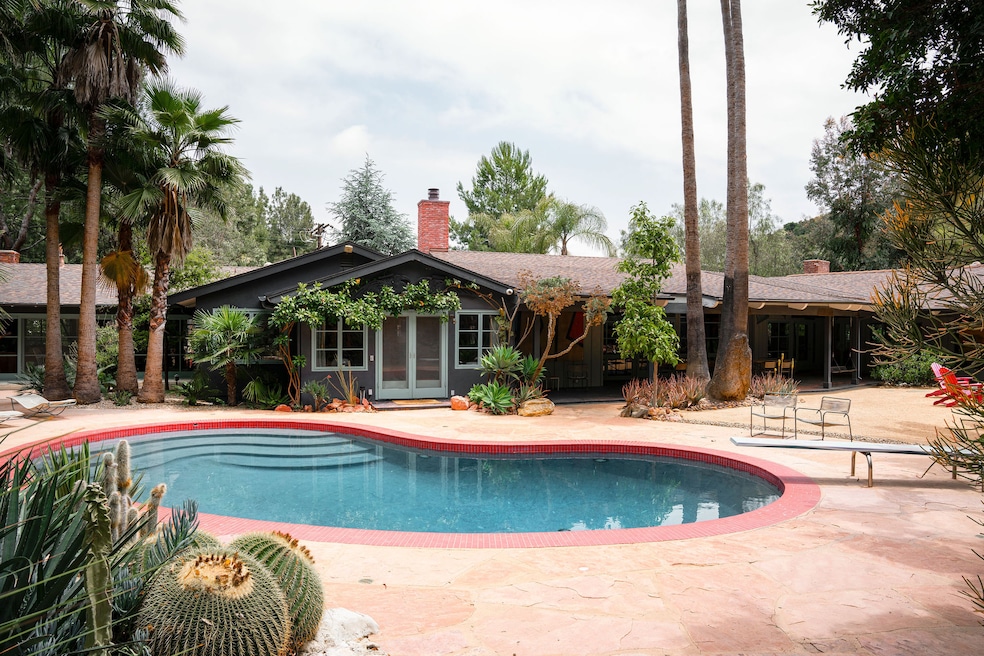Shortly after artist Ed Ruscha and his wife, Danica, bought their first ranch on Mandeville Canyon Road in 1990, the house next door went on the market.
That worried them.
The couple was concerned "that somebody was going to tear it down and build a big house,” explained broker Frank Langen. So, to prevent that outcome, the Ruschas bought it and connected the properties, uniting them into a single compound spanning more than 6,000 square feet.
By securing both homes and connecting them, the pair did, in fact, create a big house, but it was low-lying, not hulking, preserving views of its surroundings in the Santa Monica Mountains. Now, the former artist's abode at 4078 Mandeville Canyon Road is on the market.
Langen, an agent with Compass who’s worked in his Los Angeles County market for three decades, has sold the house twice before, and now he has it listed for $4.65 million.
It's the 'ranch house aesthetic but executed on a grand scale'
After Ruscha, an American artist known for his anti-pop aesthetic, and his wife secured both homes, they worked with designer Morgan Livingston to knit the properties together, demolishing most of the second ranch and then reconceiving it "as an addition, retaining all the accoutrements of the ranch house aesthetic but executed on a grand scale,” wrote critic Hunter Drohojowska-Philp in her 1994 coverage for Architectural Digest.


It’s a ranch aesthetic that persists, Langen noted. “It really feels like a mini ranch. It feels like it’s a property that would have horses or livestock.”
Goodbye to 'the pressure of capitalism and consumerism'
The family held on to the compound until 2002, when they sold the four-bedroom, six-bathroom property to buyer Gillette Regent Square Trust for $1.95 million. In 2011, the trust sold the property to film and commercial producer Rhea Scott for $2.5 million.


Scott, the current owner, produced music videos for names including Janet Jackson, the Red Hot Chili Peppers, the Rolling Stones, Madonna, and Lauryn Hill, and she’s maintained the property’s artistic backbone. Over the years, she’s had artists complete artworks on the property, Langen recalled, including a rodeo mural that spans the exterior and a graphic pattern painted across the kitchen floor.
“This house, when you walk in, it gives you that feeling of '60s California, just grace and easy living with creativity,” Langen said. “The pressure of capitalism and consumerism is not suffocating you in this house.”
Scott also added a meditation studio toward the back of the main home, which looks onto a kidney-shaped pool and cactus garden. Through the garden, a path leads to a one-bedroom guest house, rounding out the three bedrooms in the main house.
Ruscha, Langen said, is “still very connected to the property,” especially its garden. From time to time, the artist visits the home to check on the palm trees he planted.
“Now, they’re like 30 to 50 feet tall,” Langen said. “He’s still very attached to the house.”

An opportunity for wildfire victims
When it comes to drawbacks, Langen said “you’re going to need a car.” Even in the infamously car-centric L.A., the broker is finding that some people are forgoing personal vehicles in the age of ride shares, but a car is “definitely something that comes with the territory” for this residence.
Langen also noted that wildfires remain top of mind for many buyers in the L.A. market; this home is “right on the apex of the Palisades fire, so a lot of buyers potentially are afraid of buying close to where the fire was,” he said.

Since the Ruschas reimagined the property, it’s sheltered groups large and small — the Ruschas had one child, Scott has four. In today’s market, the broker also sees this one-level ranch as an interesting opportunity for older victims of this year's Los Angeles wildfires.
“There’s a lot of older people that are looking for houses, that are in the 60s that have lost everything,” Langen said. “And this is also, you know, potentially for someone like that.”
